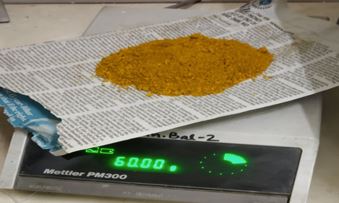Extraction process of Haridra & Tulsi essential oil with their medicinal uses
DOI:
https://doi.org/10.21760/jaims.7.5.7Keywords:
Essential oil, Extraction process, Tulasi, Haridra, Ayurveda, Clevenger apparatus.Abstract
Essential oils as defined by the European Pharmacopeia 7th edition as “Odorant products, which have the complex composition, and obtained from plant raw extract, either extracted by steam of water, dry distillation or a suitable mechanical method without heating. Generally, a physical method is used for the separation of essential oil from the aqueous phase which has no significant change in its chemical composition”. The essential oils are extracted from different aromatic plants. In this article we chose Haridra (Curcuma longa) and Tulsi (Ocimum sanctum) plants. So, these plants essential oils were selected for the present study. The oil was obtained from the both plants. Haridra rhizome paste and Tulsi fresh leaves were taken for essential oil. The extraction process was carried out with the help of Clevenger apparatus.
Downloads
References
Sell 2006; Miguel2010
Tongnuanchan, P.; Benjakul, S. Essential Oils: Extraction, Bioactivities,and Their Uses for Food Preservation. J. Food Sci., 2014,79, 1231–1249).
Avila-Ramos F, Pro-Martı´nez A et al (2012) Effects of dietary oregano essential oil and vitamin E on the lipid oxidation stability of cooked chicken breast meat. Poult Sci 91(2):505–511 Avila-Sosa R, Palou E et al (2012)
Antifungal activity by vapor contact of essential oils added to amaranth, chitosan, or starch edible films. Int J Food Microbial 153(1):66–72
El Asbahani, A.; Miladi, K.; Badri, W.; Sala, M.; Addi, E.H.A.; Casabianca, H.; El Mousadik, A.; Hartmann, D.; Jilale, A.; Renaud,F.N.R.; Elaissari,A. Essential oils: From extraction to encapsulation. Int. J. Pharm., 2009, 483, 220–243.
Bruneton, J. Pharmacognosy, phytochemistry, medicinal plants. Lavoisier publishing, 1995.
Masango, P. Cleaner production of essential oils by steam distillation. J. Clean Prod., 2005, 13, 833–839.
Essential Oils and Their Applications - A Mini Review Richard Ansah Herman, Ellen Ayepa, Saidi Shittu, Sandra Senyo Fometu and Jun Wang
Ozel MZ and H Kaymaz (2004) Superheated water extraction, steam distillation and Soxhlet extraction of essential oils of Origanum onites. Analytical and bio analytical chemistry 379: 1127-1133.
Babu, K.G.D.; Kaul, V.K. Variation in essential oil composition ofrose scented geranium (Pelargonium sp.) distilled by different distillation techniques. Flavour Fragr. J., 2005, 20, 222–231.
In another study, Yildirim et al. reported a component 2,2-diphenyl-1-picryl hydrazyl (DPPH) used to evaluate the antioxidant properties of essential oils by using steam distillation extraction process. It was reported to have a higher yield of antioxidant components than the oils extracted by hydro distillation (HD)
Eboibi BE-O, Lewis DM, Ashman PJ, Chinnasamy S. Hydrothermal liquefaction of microalgae for bio crude production: improving the bio crude properties with vacuum distillation. Bio resource technology. 2014;174:212-21.
Prado, J.M.; Vardanega, R.; Debien, I.C.N.; Meireles, M.A.d.A.; Gerschenson, L.N.; Sowbhagya, H.B.; Chemat, S. Conventional extraction. In Food Waste Recovery; Galanakis, C.M., Ed.; Academic Press: San Diego, CA, USA, 2015; pp. 127–148.
Masango, P. Cleaner production of essential oils by steam distillation. J. Clean Prod., 2005, 13, 833–839.
Insecticidal and genotoxic activity of plant, Psoralea corylifolia against Culex quinquefasciatus Arvind Kumar Dr. V. K. Dua. Dr. Sunita Sharma Scientist F Lecturer Director-in-Charge Department of Biotechnology National Institute of Malaria Research MITS, Gwalior New Delhi .
Masango, P. Cleaner production of essential oils by steam distillation. J. Clean Prod., 2005, 13, 833–839.
[Vani RS, Cheng SF, Chuah CH. Comparative Study of Volatile Compounds from Genus Ocimum.Am J of Appl. Sci. 2009; 6:523-528.
Khan A, Ahmad A, Akhtar F, Yousuf S, Xess I, Khan LA et al. Ocimum sanctum essential oil and its active principles exert their antifungal activity by disrupting ergosterol biosynthesis and membrane integrity. Res Microbiol. 2010; 161:816-823.
Anbarasu K, Vijayalakshmi G. Improved shelf life of protein-rich tofu using Ocimum sanctum (tulsi) extracts to benefit Indian rural population. J Food Sci. 2007;72:M 300-05.
Mondal S, Bijay R, Miranda RB, Sushil CM. The Science behind Sacredness of Tulsi (Ocimum sanctum LINN.). Ind J of Physiol Pharmacol. 2009; 53:291-306.
Singh S, Taneja M, Majumdar KD. Biological Activity of Ocimum Sanctum Fixed oil-An Overview. Ind J of Exp Biology. 2007; 45:403-412.
Mondal S, Bijay R, Miranda RB, Sushil CM. The Science behind Sacredness of Tulsi (Ocimum sanctum LINN.). Ind J of Physiol Pharmacol. 2009; 53:291-306.
Cronin, J.R. Curcumin: Old spice is a new medicine. Journal of Alternative & Complementary Therapies. 2003;9(1):34-8.
Allen PC, Dan forth HD, Augustine PC. Dietary modulation of avian coccidiosis. Int J Parasitol. 1998; 28:1131-40
Pitasawat B, Choochote W, Tuetun B, Tippawangkosol P, Kanjanapothi D, Jitpakdi A et al.
Zhang X-S, Yang G-X, Jiang H, Liu W-J, Ding H-S. Mass production of chemicals from biomass-derived oil by directly atmospheric distillation coupled with co-pyrolysis. Scientific Reports. 2013;3:1120.
Speight JG. The chemistry and technology of petroleum: CRC press; 2014.
Repellency of aromatic turmeric Curcuma aromatica under laboratory and field conditions. J Vector Ecol 2003; 28(2):234-40.
Kojima H, Yanai T, Toyota A. Essential oil constituents from Japanese and Indian Curcuma aromatica rhizomes. Planta Med 1998; 64(4):380-1
Mishra P. and Mishra S. Study of antibacterial activity of Ocimum sanctum extract against gram positive and gram negative bacteria. American J of Food Tech. 2011;6:336-341.
Balakumar S., Rajan S., Thirunalasundari T. and Jeeva S. (2011). Antifungal activity of Ocimum sanctum Linn. (Lamiaceae) on clinically isolated dermatophytic fungi. Asian Pac J Trop Med. 4:654-657.
Khan A., Ahmad A., Akhtar F., Yousuf S., Xess I., Khan L.A. and Manzoor N. (2010). Ocimum sanctum essential oil and its active principles exert their antifungal activity by disrupting ergosterol biosynthesis and membrane integrity. Res Microbiol.161:816-823.
Rajamma A.J., Dubey S., Sateesha S.B., Tiwari S.N. and Ghosh S.K. (2011). Comparative larvicidal activity of different species of Ocimum against Culex Quinquefasciatus. Nat Prod Res. 25:1916-1922.
Singh S. and Majumdar D.K. (1997). Evaluation of antiinflammatory activity of fatty acids of Ocimum sanctum fixed oil. Indian J Exp Biol. 35:380-383















